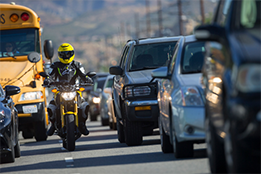Motorcycle Safety Information
Lane Splitting:
Effective January 1, 2017, section 21658.1 was added to the California Vehicle Code and defines lane splitting. The following is section 21658.1 in its entirety:
21658.1 (a) For the purposes of this section, “lane splitting” means driving a motorcycle, as defined in Section 400, that has two wheels in contact with the ground, between rows of stopped or moving vehicles in the same lane, including on both divided and undivided streets, roads, or highways.
(b) The Department of the California Highway Patrol may develop educational guidelines relating to lane splitting in a manner that would ensure the safety of the motorcyclist and the drivers and passengers of the surrounding vehicles.
(c) In developing guidelines pursuant to this section, the department shall consult with agencies and organizations with an interest in road safety and motorcyclist behavior, including, but not limited to, all of the following
(1) The Department of Motor Vehicles.
(2) The Department of Transportation.
(3) The Office of Traffic Safety.
(4) A motorcycle organization focused on motorcyclist safety.
